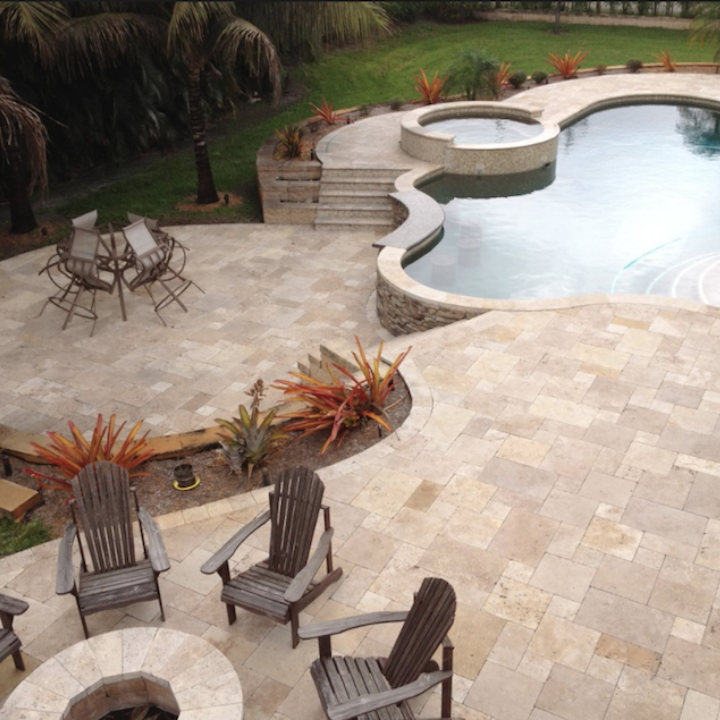Master the Art: Best Practices for Installing Travertine Pavers!
If you’re thinking about enhancing your outdoor space, travertine pavers are a fantastic choice. Not only do they bring a touch of elegance to patios and walkways, but they’re also durable and low-maintenance. In this guide, we’ll walk you through the best practices for installing travertine pavers, ensuring that your project turns out beautifully. Plus, if you want expert help, Select Lakeland Pavers is here to handle all your travertine needs!
Understanding Travertine Pavers
What Are Travertine Pavers?
Travertine is a natural stone that’s formed in mineral-rich hot springs, giving it unique textures and colors. These pavers come in various shades, from earthy browns to soft creams, which can seamlessly blend with any landscape. The versatility and charm of travertine make it a popular choice for homeowners looking to create stunning outdoor spaces.
Benefits of Choosing Travertine Pavers
Travertine pavers are not just pretty—they’re also practical! Here are some key benefits:
- Durability: Travertine is known for its long-lasting qualities. It can withstand various weather conditions, making it perfect for both hot summers and chilly winters.
- Aesthetic Appeal: The natural beauty of travertine adds a touch of luxury and warmth to your home’s exterior.
- Eco-Friendliness: Being a natural stone, travertine is sustainable and a great choice for environmentally-conscious homeowners.
Preparing for Installation
Site Assessment
Before diving into the installation, it’s crucial to assess your site. Look for potential drainage issues, soil conditions, and any existing structures that might affect the layout. A well-draining area is essential for preventing water buildup that could damage your pavers over time.
Planning and Design
Creating a layout plan is a must. Think about how you want your pavers to be arranged—do you prefer a classic pattern or something more modern? Sketching out your design will save time and help ensure everything flows nicely.
Essential Tools and Materials
Required Tools
Having the right tools is vital for a successful installation. Here’s a quick checklist:
- Paver Saw: For cutting pavers to fit.
- Level: To ensure a flat surface.
- Compactor: For solidifying the base layer.
- Rubber Mallet: To gently tap pavers into place without cracking them.
Selecting Quality Materials
Not all travertine pavers are created equal. Be sure to source high-quality materials from reputable suppliers. This investment will pay off in durability and aesthetics!

Installation Best Practices
Proper Base Preparation
The foundation of your installation is critical. A well-prepared base will keep your pavers stable. Start by excavating the area to a depth of at least 6-8 inches. Next, layer gravel and compact it to create a sturdy, level surface. This will ensure proper drainage and reduce the risk of shifting.
Laying the Pavers
Once your base is ready, it’s time to lay the pavers. Start from a corner and work your way out, ensuring they are aligned and evenly spaced. This part can make or break the look of your installation, so take your time!
Jointing and Grouting
Filling the gaps between pavers is essential to prevent them from shifting. You can use sand or polymeric jointing material, which helps to stabilize the pavers while also preventing weeds from growing in between.
Sealing and Finishing Touches
Importance of Sealing Travertine
After installation, sealing your travertine is a must. This protective layer helps guard against stains and wear, extending the life of your pavers. Look for a high-quality sealant and follow the manufacturer’s instructions for application.
Final Inspection and Cleanup
Once everything is installed and sealed, conduct a final inspection. Check for any uneven pavers or gaps that need attention. A good cleanup will also make a significant difference in the overall appearance of your new patio or walkway.
Maintenance Tips for Longevity
Regular maintenance is key to keeping your travertine pavers looking fresh. Sweep away debris and use a gentle cleaner periodically to remove stains. Avoid harsh chemicals that can damage the stone.
Over time, you may encounter issues like small cracks or shifting pavers. Address these promptly with appropriate repairs to maintain the beauty and integrity of your installation.
Frequently Asked Questions
Travertine offers a natural, elegant look with excellent slip resistance, making it ideal for pool areas.
Yes, travertine is highly durable and can withstand weather and foot traffic.
Sealing helps protect against stains and enhances the stone’s natural color.
Travertine is typically used for patios and pool decks rather than driveways due to its softer nature.
